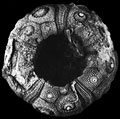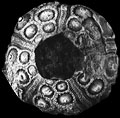The Echinoid Directory
Contributed by Andrew Smith, April 2011
Desoricidaris Geys, 1992, p. 140
[includes species that have wrongly been assigned to Leiocidaris Desor, 1855 previously]
| Diagnostic Features |
|
|---|---|
| Distribution | Cretaceous of southern Europe, North Africa and the Middle East. |
| Name gender | feminine |
| Type | Rhabdocidaris pouyannei Cotteau, 1863, p. 346, by original designation. |
| Species Included | Geys (1992) included the following taxa when establishing this genus:
|
| Classification and/or Status | Cidaroida; Cidaridae; Stereocidarinae |
| Remarks | This genus was established for cidarids with non-crenulate tubercles and strongly conjugate pore-pairs. These have often been assigned to the genus Leiocidaris by older authors but Leiocidaris is a synonym of Phyllacanthus. The type species, with its well-developed extrascrobicular zones, sunken sutures and adapical interambulacral plates that lack fully developed tubercles has close affinities with the Stereocidarinae and is here treated as a genus of that subfamily. Geys,J. F. 1992. Regular echinoids, other than Hemicidaroida, from Upper Cretaceous deposits in the Wadi Qena-area (Eastern Desert, Egypt). Bulletin de l'Institut Royal des Sciences naturelles de Belgique. Sciences de la Terre 62, 139-154. |



